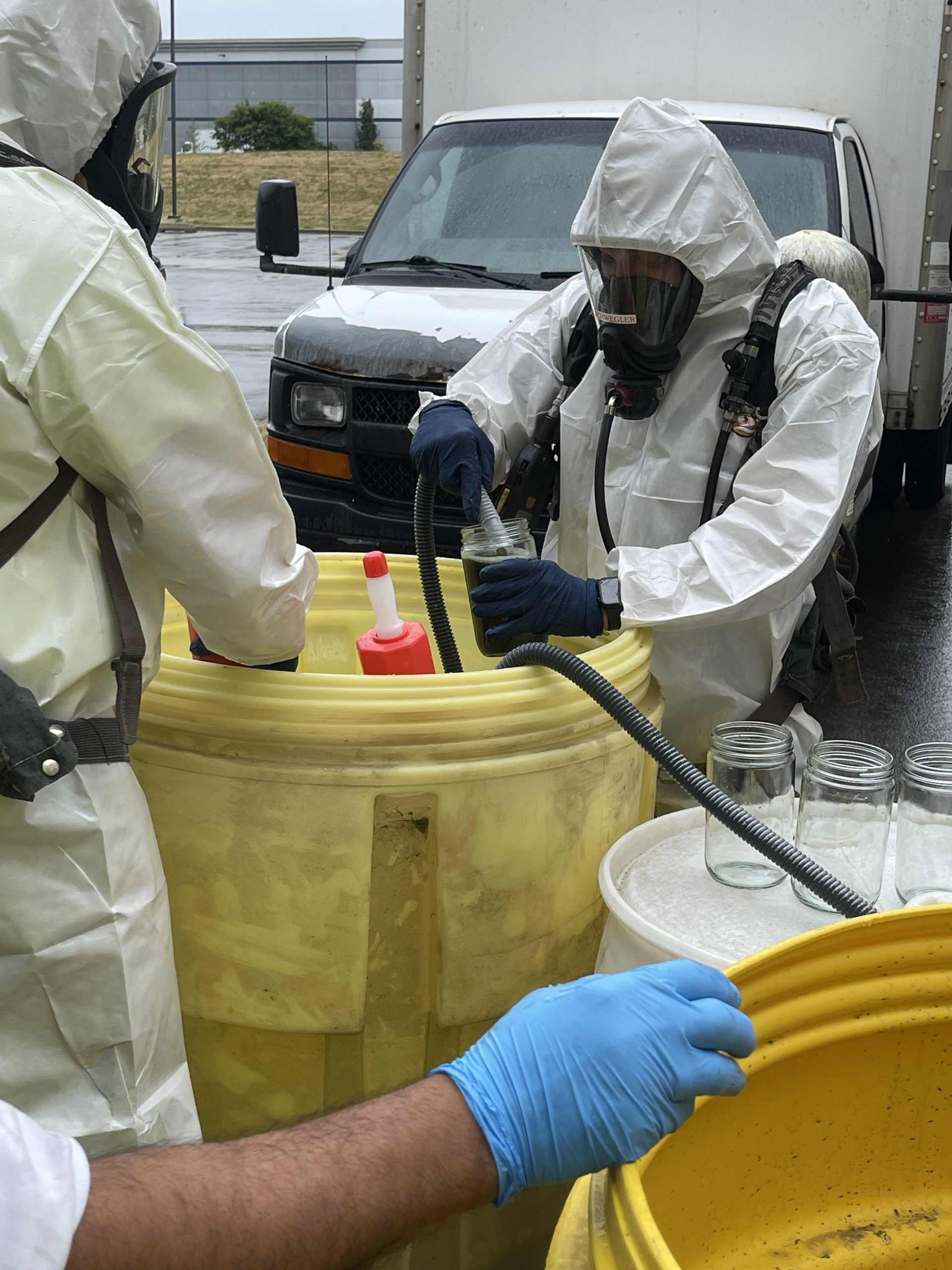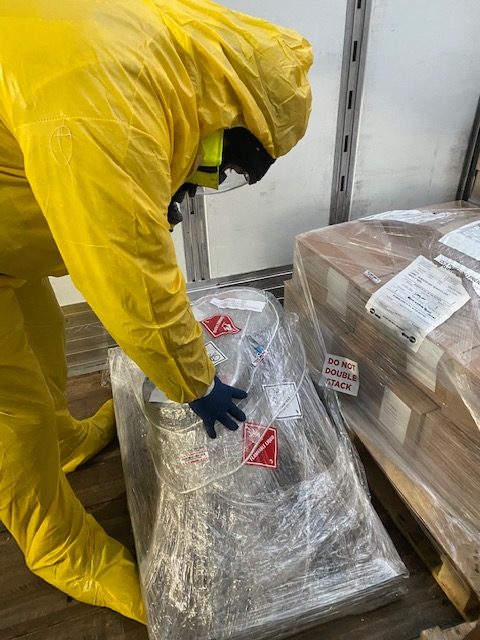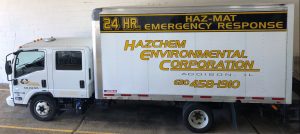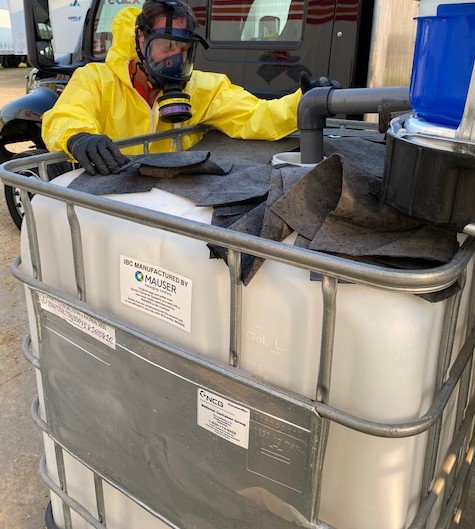HAZMAT CLEANING SERVICES

HAZMAT Clean Up Response
HazChem Environmental provides a wide range of HAZMAT cleaning services. The term HAZMAT refers to a hazardous material; one which which may be flammable or poisonous, that would pose a danger to life or a threat to the environment. Our Emergency Rapid Response team members are all HAZWOPER trained professionals with more than three decades of experience in handling hazardous materials, biohazardous waste, chemical leaks and chemical spills, HAZMAT releases, hazardous spills, HAZMAT spills, and other hazardous waste. Unforeseen HAZMAT clean up emergencies can be both unpredictable and financially burdensome, causing disruptions to regular business operations and jeopardizing the safety of employees. Our Emergency Rapid Response Teams can provide HAZMAT response services which include biohazard clean up, hazard waste clean up, hazardous waste disposal, and other HAZMAT cleaning service 24/7/365.
Why HAZMAT Cleaning Services are Crucial
In the absence of adequate hazardous waste removal and hazardous waste disposal procedures, hazardous waste poses a threat of exposure and toxicity to workers, residents, and the natural environment. Chemicals and asbestos materials contained in these wastes have the potential to cause respiratory illnesses and even cancer in humans. Furthermore, hazardous waste can infiltrate the soil used for food cultivation and leach into groundwater sources that communities rely on for drinking water. Proper hazardous waste removal and disposal is not only crucial for the immediate safety of workers involved in the HAZMAT cleaning process but also vital for the long-term well-being of the entire community.
SUPER-FAST 60-Minute Response Time for HAZMAT Clean Up Services
We understand the urgent and critical nature of your call for service. Our Emergency Rapid Response Teams are ready, willing and able to respond quickly to remedy your emergency spill situation. Our Emergency Response Vehicles are pre-loaded with 90% of the equipment needed for any emergency situation. The final 10% will be added for your particular needs. This advance preparation enables us to deploy a Team within 60 minutes or less from our facility. Based upon our clients’ feedback, this is far better than the typical response time from most of our competitors. Their response is usually measured in multiple hours, and sometimes days or even weeks. Our Team is always ready to deploy, 24 hours a day, 365 days per year, rain or shine, including holidays. We do not rely on automated answering systems for our main phone line (630) 458-1910. Instead, we guarantee that a live person will answer your call, regardless of whether it is a weekend, holiday, or any other day.
We are always open: Call (630) 458-1910 for IMMEDIATE ASSISTANCE
Reliable HAZMAT Clean up Response: You Can Depend On HazChem
If you’re seeking to alleviate concerns related to HAZMAT clean up and spill cleanups, you need a team of experts you can trust. A hazardous spill can occur at any time. Feel free to reach out to HazChem for dependable emergency HAZMAT response and HAZMAT cleaning services. Hazardous materials encompass substances, be they biological, chemical, radiological, or otherwise, that possess the potential to cause harm to the well-being and safety of individuals, the general public, or the environment. These materials encompass a wide range, from explosives and flammable compounds to poisons and radioactive substances. Chemical agents consist of poisonous vapors, aerosols, liquids, and solids that can exert detrimental effects on humans, animals, or plant life. Emergencies related to hazardous materials can arise at various stages, including production, storage, transportation, usage, or disposal.
HazChem is fully equipped to tackle your HAZMAT spill or HAZMAT release.
This includes:
-
- The use of proper personal protective equipment.
- Access to supplies for spill containment and spill clean up.
- Utilization of suitable meters and monitors to ensure respiratory safety.
- The generation of comprehensive reports that outline spill details, spill cleanup efforts, and clearance readings, which are shared with local regulatory agencies and your insurance company.
Comprehensive HAZMAT Cleaning Services
Our HAZMAT Cleaning Services are at your service 24/7, and our expertise extends beyond HAZMAT Clean up. We are proficient in handling a wide range of emergency situations, such as:
-
- Developing emergency response preparedness plans.
- Managing hazardous and non-hazardous waste and materials.
- Addressing chemical spills or a hazardous spill.
- Handling mercury spills.
- Responding to waterway, rail, industrial, and commercial or transport emergencies.
- Managing high-hazard and energetic waste.
- Investigating unknown odors.
- Addressing natural disasters.
- Managing incidents such as fires, floods, hurricanes, and tornadoes.
- Safety training.
UNDERSTANDING HAZARDOUS WASTE:
Hazardous waste is the term applied to substances possessing harmful or perilous characteristics. While movies and television often portray it as a mysterious, oozing green liquid, the reality is that identifying hazardous waste can be much more complex. It can manifest as a liquid, solid, or gas, sometimes remaining invisible to the naked eye. Often, it comprises by-products from manufacturing processes, including discarded materials and unused commercial products like cleaning fluids and pesticides. Here are some examples:
Examples of Hazardous Waste:
-
-
- Flammable Materials
- Corrosive Substances
- Reactive Compounds
- Acids and Caustics
- Toxic Metals
- Used Solvents
- Sludge
- Contaminated Soils

- Plating Solutions
- Cleaning Solutions
- Lab Pack Materials
-
Chemical Waste Management:
-
-
- Chemical Recycling
- Acid Disposal
- Glycol Disposal
- Acetone Disposal
- Acetonitrile Disposal
- Cyanide Waste Disposal
- Ammonia Disposal
- Pesticide Disposal
-
Laboratory Waste Handling:
-
-
- Lab Packs
- Management of Laboratory Waste
- Chemistry Lab Waste
- Disposal of Unused Chemicals
-
CHARACTERISTICS OF HAZARDOUS WASTE:
Hazardous waste possesses four key characteristics: ignitability, corrosivity, reactivity, and toxicity.
-
- Ignitability: Ignitable wastes have a flash point below 60 °C (140 °F), making them prone to fires or spontaneous combustion. Examples include waste oils and used solvents. These materials can be in solid or liquid form. Liquids are especially concerning due to their flash point, while solid ignitables can ignite through friction, moisture absorption, or chemical changes, creating hazardous situations.
- Corrosivity: Corrosive wastes are highly acidic or basic (with a pH ≤ 2 or ≥ 12.5) and can corrode metal containers like storage tanks and drums. Battery acid is a typical example. Corrosive hazardous materials can exist in liquid or solid states and pose risks to both human skin and metal structures.
- Reactivity: Reactive wastes are intrinsically unstable under standard conditions and can trigger explosions, release toxic fumes, gases, or vapors when exposed to heat, pressure, or water mixing. Examples encompass lithium-sulfur batteries and explosives. Reactive wastes are inherently unstable and may form hazardous gases, posing health risks, with some even capable of detonating or exploding.
- Toxicity: Toxic wastes, such as those containing mercury or lead, can be harmful or fatal when ingested or absorbed. Improper disposal may lead to contaminated liquid leaching into the ground and polluting groundwater.
Categories of Hazardous Waste
To comprehend the risks associated with these substances and their appropriate disposal techniques, one must begin by gaining a comprehensive understanding of the hazardous waste classification. The Environmental Protection Agency has identified four primary categories of hazardous waste.
-
- F-List Waste: This waste category originates from unspecified sources but is a byproduct of manufacturing and industrial processes. Examples of hazardous waste found on this list include sludges from petroleum refinery wastewater treatment and waste from wood-preserving activities.
- K-List Waste: In contrast, K-list waste is more specific in terms of its source. It is often linked to activities like ink formulation and pesticide manufacturing, making it more targeted in origin.
- P-List and U-List Waste: These categories encompass commercial chemical products that require disposal but have not been used.
- Universal Hazardous Waste: This category comprises waste generated by the general public and includes items like batteries and thermometers.
Additionally, there is mixed waste, which contains both hazardous and radioactive components. Many misconceptions exist among the public regarding proper hazardous waste disposal. Despite the potential infrequency of interactions with hazardous waste for forklift operators, it remains imperative for them to grasp the distinctions among these categories and understand the correct disposal methods. This knowledge safeguards their well-being and that of others, particularly concerning items like forklift batteries.
Recognize a HAZMAT Release or HAZMAT Spill
Signs of a chemical HAZMAT release or spill include cues related to the event, the environment, and potential victims. The cues linked to the event and environment are those that can reasonably be perceived by individuals who are not HAZMAT specialists, and they can do so from a safe distance away from the incident scene. Meanwhile, victim-related cues refer to information that can be observed or gathered from witnesses by non-medical responders situated at a safe distance from the incident.
Noteworthy Indicators of a Chemical HAZMAT Release: 
-
- Observation of a chemical release or chemical spill
- Damage to a HAZMAT container or chemical-related container
- Presence of an unexplained cloud not associated with a fire
- Appearance of a colored cloud in the air
- Detection of unusual odors
Additional Environmental Cues to Be Mindful Of:
-
- Discovery of deceased or injured animals in the vicinity
- Identification of unexplained liquids or powders
- Observation of oily coatings on surfaces
- Noticing withered plant life
Regarding Potential Victims:
-
- Be vigilant for any casualties or signs of medical distress in workers, particularly if multiple individuals are affected.
- Stay alert for symptoms such as burns on the skin, irritation, watery eyes, difficulty breathing, or disorientation among workers.
Biohazard Clean Up and Decontamination
Any substance containing or capable of transmitting biological hazards presents a significant health threat. Therefore, attempting to perform biohazard clean up on your own is strongly discouraged. Call our HAZMAT professionals will provide the following HAZMAT cleaning services:
Preventing Cross-Contamination We will take measures to prevent the spread of biohazards during the removal and disinfection processes.
Biohazard Removal Properly dispose of materials contaminated with biohazards, including items like drywall, wood, and carpeting.
Cleaning, Deodorizing, and Disinfecting Thoroughly clean, deodorize, and disinfect the area to prevent the dissemination of contaminants.
Restoration Restore the affected area to its original condition.
Common Biohazards Include:
• Blood • Bodily Fluids • Biological Material • Medical Waste • Unattended Deaths • Suicides / Homicides • Crime Scenes • Illegal Drug Labs/Paraphernalia • Chemical Waste • Toxic Chemicals • Animal Waste and Feces • Rodents and Nuisance Animals • Asbestos • Lead • Sewage backups
The EPA classifies hazardous waste as “waste that is dangerous or potentially harmful to our health or the environment.”
WHAT TO DO IF A HAZMAT CLEAN UP IS NEEDED:
In the event of a chemical release, HAZMAT spill or potential exposure to hazardous materials, follow these guidelines:
- Avoid Further Exposure: Take immediate steps to minimize contact with the hazardous materials
- Contact HAZCHEM and POLICE: Call 911 and 630-458-1910 once you are in a safe location.
- Provide Information: Be ready to furnish details about the material involved, its quantity, the incident’s location, the number of affected individuals, and whether there has been a fire or explosion.
- Follow Instructions: Comply with all directives provided by emergency personnel.
- Evacuate if Necessary:
-
- If you feel the area is unsafe or are instructed to do so by responders, leave immediately.
- If it’s safe, inform others about the incident and encourage them to evacuate.
- Assist those who require help in leaving.
- Advise exposed individuals to remain nearby until emergency responders arrive.
- Isolate the affected area and await instructions from responders before returning.
-
Take Action ONLY if Trained:
-
- If trained and without risking exposure, turn off potential sources of ignition.
- If safe, try to prevent further chemical release.
- Make efforts to block drains or use absorbent materials to prevent chemicals from entering them.
- Locate and provide the Material Safety Data Sheet (MSDS) for the released chemical to responders.
- Outdoor Incident:
- If the incident occurs outdoors, close doors and windows if feasible.
- You may be directed to seek shelter indoors and follow “SHELTER IN PLACE” instructions if you are outdoors during the emergency.
IMPORTANT: DO NOT PUT YOURSELF AT RISK OF EXPOSURE TO HAZARDOUS MATERIALS. AVOID ATTEMPTING TO CLEAN UP A HAZMAT SPILL OR HAZMAT RELEASE UNLESS YOU ARE TRAINED AND HAVE APPROPRIATE EQUIPMENT.
How is Hazardous Waste Managed and Eliminated? Call HazChem Environmental
The initial step in managing hazardous waste involves proper identification. Waste removal personnel must pose four critical questions to accurately determine whether a waste falls under the RCRA definition of hazardous waste:
-
- Is the substance categorized as solid waste?
- Is the waste explicitly exempted from RCRA regulations?
- Is the waste classified as a listed hazardous waste?
- Does the waste exhibit characteristics of hazardous waste?
Once hazardous waste is identified, its correct removal becomes paramount to prevent potential health hazards and environmental disruption. It is best to contact HazChem Environmental to provide HAZMAT cleaning services in order to avoid contamination or injury.
The notification should include key information about the event, following local protocol or Standard Operating Guidelines. A variation of the widely used METHANE protocol is also frequently used in the absence of Standard Operating Guidelines:
-
-
- Major Incident: Declare a HAZMAT or Mass Casualty Incident
- Exact location: The precise location of the incident
- Type: Chemical HAZMAT, Chemical MEI, or Chemical WMD Incident
- Hazards: Both present and potential
- Access: Best route for emergency access the site, or obstructions to avoid
- Numbers: Estimate of numbers of contaminated, casualties, and uninjured on scene
- Emergency services: Which services are already on scene, and which others are required
-

LEVEL A HAZMAT EMERGENCY SPILL RESPONSE TRAILERS
Our fully equipped HAZMAT emergency response spill trailers are designed for transport to remote locations, allowing our crew members to work efficiently even in highly dangerous conditions. HAZMAT cleanups and management of biological hazards are among our specialties. We are always prepared to handle hazardous waste spills, contain biohazardous materials and provide emergency cleanup services quickly and efficiently.
View other HazChem Services.

Compliant. Responsive. Safe.
Call 630-458-1910 for immediate assistance. Open 24/7/365
For a FREE, no-obligation quote, click the button below

